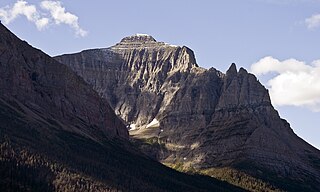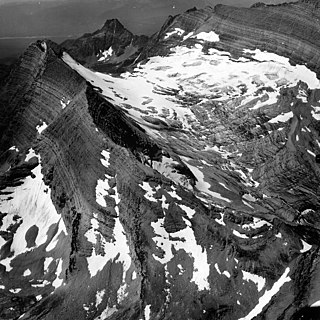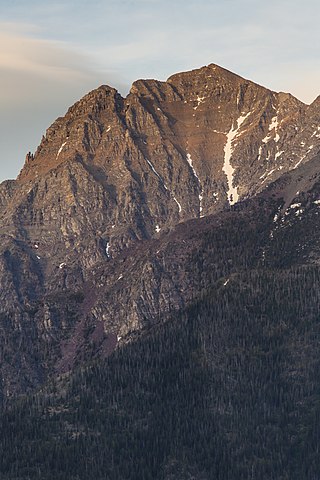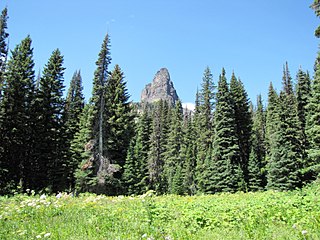
Heavens Peak is located in the Livingston Range, Glacier National Park in the U.S. state of Montana. Heavens Peak is a little more than 1 mile (1.6 km) north of McPartland Mountain. The mountain's descriptive name first appeared on a map prepared by Lt. George P. Ahern, from 1888 to 1890 reconnaissance maps prepared by him. This geographical feature's name was officially adopted in 1929 by the United States Board on Geographic Names.

Ahern Peak is located in the Lewis Range, Glacier National Park in the U.S. state of Montana. The mountain was named after George Patrick Ahern. Ahern Peak is immediately southwest of Helen Lake and straddles the Continental Divide. Ahern Glacier lies just north of the peak.

Apikuni Mountain is located in the Lewis Range, Glacier National Park in the U.S. state of Montana.

Blackfoot Mountain is located in the Lewis Range, Glacier National Park in the U.S. state of Montana. To the north of Blackfoot Mountain lies Blackfoot Glacier, one of the largest glaciers in the park. The stagnant Pumpelly Glacier is located to the immediate east and northeast of the mountain.

Cracker benchmark is located in the Lewis Range, Glacier National Park in the U.S. state of Montana. Cracker is a benchmark summit located on a ridgeline 0.5 miles (1 km) northeast of Mount Siyeh.
Crowfeet Mountain is located in the Lewis Range, Glacier National Park in the U.S. state of Montana. Crowfeet Mountain is situated on a ridgeline just south of the Ptarmigan Tunnel and is easily seen from Iceberg Lake to the southwest.

Divide Mountain is located in the Lewis Range, Glacier National Park in the U.S. state of Montana. Divide Mountain is located south of Saint Mary, Montana on the border of Glacier National Park and the Blackfeet Indian Reservation.

Gable Mountain is located in the Lewis Range, Glacier National Park in the U.S. state of Montana. Gable Mountain is in the northeastern section of Glacier National Park, approximately 3 miles (4.8 km) southwest of the prominent Chief Mountain.

Grizzly Mountain is located in the Lewis Range, Glacier National Park in the U.S. state of Montana. Grizzly Mountain sits astride the Continental Divide in the Two Medicine region of Glacier National Park.

Little Chief Mountain is located in the Lewis Range, Glacier National Park in the U.S. state of Montana. Little Chief Mountain is easily seen from the Going-to-the-Sun Road, rising to the south of Saint Mary Lake. Little Chief Mountain was named in 1887 by George Bird Grinnell for his friend, Frank North, U.S. Army. "Little Chief" was his Pawnee name, given to him by his Pawnee Scouts.

Mount Ellsworth is located in the Lewis Range, Glacier National Park in the U.S. state of Montana. Mount Ellsworth is in the southeastern section of Glacier National Park and can be seen from Two Medicine Lake and surrounding areas. Mount Ellsworth is named, "for "Billy" Ellsworth, an oldtimer who packed for the U. S. Geological Survey."

Mount Morgan is located in the Lewis Range, Glacier National Park in the U.S. state of Montana. Mount Morgan is situated along the Continental Divide. Oldman Lake is immediately east of the peak.

Seward Mountain is located in the Lewis Range, Glacier National Park in the U.S. state of Montana.

Longfellow Peak is located in the Livingston Range, Glacier National Park in the U.S. state of Montana. Longfellow Peak is immediately north of Paul Bunyans Cabin, a rock formation that resembles a log cabin from a distance. Lake Evangeline is northeast of the peak and Ruger Lake is to the east. The mountain was named by R. H. Sargent, topographer for the US Geological Survey in the early mapping of Glacier Park, to honor the American poet Henry Wadsworth Longfellow, (1807–1882).

Mount Peabody is located in the Livingston Range, Glacier National Park in the U.S. state of Montana. Agassiz Glacier is located on the western slopes of Mount Peabody.

Vulture Peak is located in the Livingston Range, Glacier National Park in the U.S. state of Montana. The Vulture Glacier is located on the southern flanks of the mountain, while the Two Ocean Glacier is immediately to the north. Vulture Peak is the thirteenth highest summit in Glacier National Park.

Dusty Star Mountain is located in the Lewis Range, Glacier National Park in the U.S. state of Montana. Connected by an arête to Citadel Mountain to the south, Dusty Star Mountain lies to the south and across the Saint Mary Valley from Going-to-the-Sun Mountain. Dusty Star Mountain is easily seen from the Going-to-the-Sun Road, and often photographed by tourists taking pictures of Wild Goose Island which lies in the western section of Saint Mary Lake. The Blackfoot name for Dusty Star is iszika-kakatosi meaning "meteor" or "smoking star".

Pumpelly Pillar is located in the Lewis Range, Glacier National Park in the U.S. state of Montana. Located in the Two Medicine region in the southeastern section of Glacier National Park, the peak is likely named after Raphael Pumpelly, who lead the Northern Transcontinental Railway Survey party that crossed Pitamakan Pass in 1883.

Olson Mountain, also known as Mount Olson, is a 7,913-foot-elevation mountain summit located in the Livingston Range, of Glacier National Park in the U.S. state of Montana. Olson Mountain rises more than 3,700 feet (1,100 m) above the western shore of Waterton Lake. The mountain was named for a surveyor on the International Boundary Survey, with the name officially adopted in 1929. The nearest higher peak is Campbell Mountain, 1.13 miles (1.82 km) to the north, and Citadel Peaks is two miles to the south. Precipitation runoff from the mountain drains into Olson Creek before it empties to Waterton Lake.

Citadel Peaks is a mountain ridge located in the Goat Haunt area of Glacier National Park, in Glacier County of the U.S. state of Montana. This arête with a row of sharp points is part of the Livingston Range, and is approximately four miles east of the Continental Divide. Neighbors include Olson Mountain, two miles (3.2 km) to the north, Mount Cleveland four miles (6.4 km) to the east, and Kootenai Peak 2.7 miles (4.3 km) to the south. Topographic relief is significant as Citadel Peaks rises over 3,800 feet above Waterton Lake in less than two miles, and 3,000 feet above Lake Janet in one mile. Precipitation runoff from the mountain drains to the south end of Waterton Lake. The first ascent of Citadel Spire, a major pinnacle on the ridge, was made in 1967 by Jerry Kanzler, Jim Kanzler, Ray Martin, and Clare Pogreba. This geographical feature's name was officially adopted in 1929 by the United States Board on Geographic Names. To the Pikuni people, Citadel Peaks is known as "Ataniawxis", meaning "The Needles".






















